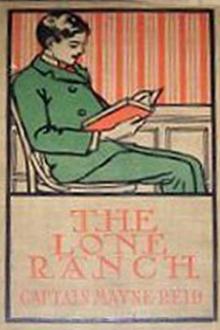The Boy Hunters, Mayne Reid [best love novels of all time .TXT] 📗

- Author: Mayne Reid
Book online «The Boy Hunters, Mayne Reid [best love novels of all time .TXT] 📗». Author Mayne Reid
The ground was covered with flowers of many kinds. There were blue lupins and golden helianthi. There were malvas and purple monardas, and flowers of the cotton-rose, five inches in diameter. There were blossoms of vines, and creeping plants, that twined around the trees, or stretched in festoons from one to another—the cane-vine with its white clusters, and the raccoon grape, whose sweet odours perfumed the air; but by far the most showy were the large blossoms of the bignonia, that covered the festoons with their trumpet-shaped corollas, exhibiting broad surfaces of bright scarlet.
In the midst of these flowers our hunters pitched camp, picketing their animals, and putting up their tent as usual.
The sun was shining brightly, and they proceeded to spread their wet robes and blankets.
“It strikes me,” said Lucien, after they had completed their arrangements for camping, “that we have halted on the site of an old Indian town.”
“Why do you think so?” asked Basil.
“Why, I notice these heaps of rubbish here that are covered with weeds and briars. They are Indian graves, or piles of decayed logs where houses once stood. I can tell from the trees, too. Look around! do you see anything peculiar in these trees?”
“Nothing,” replied Basil and François together. “Nothing, except that they are mostly small and low.”
“Do you not observe anything odd in their species?”
“No,” said Basil. “I think I have seen them all before. There are mulberry-trees, and black walnuts, and Chicasaw plums, and pawpaws, and Osage orange, and shell-bark hickories, and pecans, and honey-locusts. I see no others except vines, and those great magnolias. I have seen all these trees before.”
“Yes,” returned Lucien, “but have you ever observed them all growing together in this way?”
“Ah! that is a different affair: I believe not.”
“Because it is from that fact,” continued Lucien, “that I am led to believe this spot was once the seat of an Indian settlement. These trees, or others that produced them, have been planted here, and by the Indians.”
“But, brother Luce,” interposed François, “I never heard that the Indians of these parts made such settlements as this must have been. These low woods extend down the river for miles. They must have had a large tract under cultivation.”
“I think,” replied Lucien, “the Indians who at present inhabit this region never planted these trees. It is more likely a settlement of the ancient nation of the Natchez.”
“The Natchez! Why, that is the name of a town on the Mississippi, but I did not know there were Indians of that name.”
“Neither are there now; but there once was a very extensive tribe so called who occupied the whole territory of Louisiana. It is said that, like the Mexicans and Peruvians, they had made some progress in civilisation, and knew how to weave cloth and cultivate the soil. They are now an extinct race.”
“How came that about?”
“No one can tell. Some of the old Spanish authors say that they were destroyed by Indians from South America. This story, however, is very absurd—as is, indeed, most of what has been written by these same old Spanish authors, whose books read more like the productions of children than of reasoning men. It is far more likely that the Natchez were conquered by the Creeks and Chicasaws, who came from the south-west of their country; and that the remnant of their tribe became blended with and lost among the conquerors. In my opinion, this is how they have come to be extinct. Why, then, should not this be one of their ancient settlements, and these trees the remains of their orchards, cultivated by them for their fruits and other uses?”
“But we make but little use of such trees,” remarked François.
“What’s that you say?” exclaimed Basil. “You, François, who every year eat such quantities of shell-bark nuts, and pecans, and red mulberries, too!—you who suck persimmons like a ’possum!—no use, eh?”
“Well, that’s true enough,” rejoined François, “but still we do not cultivate these trees for their fruits—we find them in the woods, growing naturally.”
“Because,” interrupted Lucien, “we have the advantage of the Indians. We understand commerce, and get other and better sorts of fruits from all parts of the world. We have cereals, too, such as wheat and rice, and many kinds which they had not; we can therefore do without these trees. With the Indians it was different. It is true they had the Indian corn or maize-plant (Zea maïz), but, like other people, they were fond of variety; and these trees afforded them that. The Indian nations who lived within the tropics had variety enough. In fact, no people without commerce could have been better off in regard to fruit-bearing plants and trees than the Aztecs, and other tribes of the South. The Natchez, however, and those in the temperate zone, had their trees and plants as well—such as those we see before us—and from these they drew both necessary food, and luxurious fruits and beverages. Indeed the early colonists did the same; and many settlers in remote places make use to this day of these spontaneous productions of Nature.”
“Would it not be interesting, Basil,” said François, appealing to his elder brother, “if Lucien would give a botanical description of all these trees, and tell us their uses? He knows all that.”
“Yes,” replied Basil, “I should like to hear it.”
“That I shall do with pleasure,” said Lucien. “Not, however, a botanical description, according to the sense of the Linnean school, as that would weary you soon enough, without adding much to your stock of information. I shall only state what I know of their properties and uses; and I may remark that there is not a tree or plant that is not intended for some use in the economy of Nature. If botanists had spent their time in trying to discover these uses, instead of wasting it in idle classifications, mankind would have been more enriched by their labours.
“Let us begin, then, with the mulberry-tree, as there are many of them growing around. Were I to tell you all about this valuable tree, I should occupy a day or more. I shall only state those facts about it that are most interesting.
“The mulberry-trees form the genus morus—for this was the name by which they were known to the ancient Greeks. Of this genus there are several well-known species. No doubt there may be other species growing in wild countries, and yet unknown or undescribed by botanists; and this remark applies as well to other trees, for every day we hear of new varieties being discovered by enterprising explorers.
“First, then, comes the white mulberry (Morus alia). It is the most important species yet known. This you will readily admit when I tell you that from it comes all our silk—spun out of it by the silkworm (Bombyx mori). It is called white mulberry on account of the colour of its fruit, which, however, is not always white, but sometimes of a purple or black colour. Now it would be difficult to give an exact description of a white mulberry-tree; for, like the apple and pear trees, there are many varieties of it produced from the same seeds, and also by difference of soil and climate. It is a small tree, however, rarely growing over forty feet high, with thick leaves and numerous branches. The leaves are the most important part of it—for it is upon these the silkworms feed, spinning their fine threads out of the milky juice, which in its properties resembles the juice of the caoutchouc tree. It is true that the silkworm will feed upon the other species of mulberries, and also upon slippery elms, figs, lettuce, beets, endive, and many kinds of leaves besides; but the silk made from all these is of an inferior quality; and even the varieties of the white mulberry itself produce different qualities of this beautiful material.
“This tree has other uses. Its wood is compact and heavy, weighing forty-four pounds to the cubic foot. In France it is much used in turnery; and wine-casks are made from it, as it gives to white wines an agreeable flavour of violets. Vine-props and fences are made from its branches; and out of its bark—by a process which I have not time to describe—a cloth can be manufactured almost as fine as silk itself. The fruit of the white mulberry—where it grows in warm climates—is very good to eat, and makes an excellent syrup.
“The white mulberry, it is supposed, first came from China, where it is still found growing wild; and the Chinese first cultivated it for feeding silkworms as early as 2700 years before the Christian era. The tree is now found in every civilised country, growing either as an ornament of the shrubbery, or for the manufacture of silk.
“The next species is the black mulberry (Morus nigra), so called on account of the colour of its fruit, which is of a dark purple, nearly black. This kind came originally from Persia, but is now, like the white mulberry, found in all civilised countries. It is cultivated more for ornament and shade than for feeding silkworms; though it is put to this use in some parts, especially in cold climates, where the other species does not thrive. They are easily distinguished from each other—the bark of the black being much rougher and darker. The wood of the latter is not so firm nor heavy as the white, but it is also durable, and is used in England for hoops, wheels, and ribs of small vessels. In Spain, Italy, and Persia, they prefer the leaves of the black for feeding the silkworm. They are also eaten by cattle, sheep, and goats. The roots when prepared are used as a vermifuge. The fruit has a pleasant aromatic taste; and is eaten both raw and in preserves, or mixed with cider makes an agreeable drink. The Greeks distil a clear weak brandy out of them; and in France they make a wine from these mulberries—which must be drunk while it is new, as it soon turns to vinegar. This fruit is good for fevers and rheumatisms; and it is much sought after by birds and all kinds of poultry, who devour it greedily.
“So much for the white and black mulberry-tree. We now come to the third species, the red (Morus rubra).
“That is the red before your face,” continued Lucien, pointing to the trees, which he had already designated. “It is so called from the fruit, which, as you know, are of a dark red colour, and resemble red raspberries more than anything in the world. Some of these trees, you see, are nearly seventy feet in height, though it usually does not reach so high. You notice the leaves. The are heart-shaped, many of them ten inches long, and nearly as broad as long. They are dark green and rough, and for feeding the silkworm quite useless where the white mulberry grows. They form a delightful shade, however; and this is one of the uses of this beautiful tree. The fruit, too, is, in my opinion—and I think François will agree with me—quite equal to the best raspberries. As for the wood, it is much used in the dockyards of the Southern states. It is of a pale lemon colour; and is considered more durable for trenails than any other—that of the locust excepted.
“The red mulberry, like the white and black species, runs into several varieties, differing considerably from each other.
“There is still a fourth species of this genus, called the paper mulberry (Morus papyrifera). This, however, has been separated by botanists into another genus; but it is worth a word here, as it is a very curious and valuable tree, or, rather, a large shrub, for it does not grow so tall as either of the other three. It is a native of China, Japan, and the islands of the Pacific Ocean; but, like the others, it is cultivated for ornament both





Comments (0)